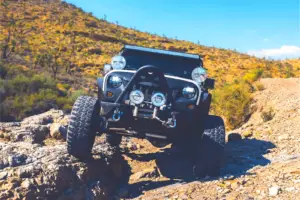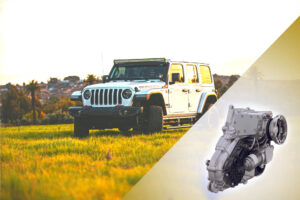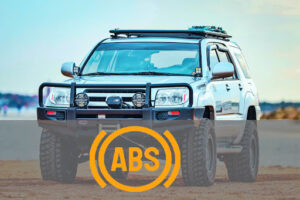Is there a difference between hub locks and differential locks? (aka diff locks) Of Course yes!
Hub Locks are placed on the two outer ends of an axle. When hub locks are engaged, it locks the front wheels to the front drive shafts. When hub locks disengaged those wheels spin freely without spinning the drive shaft.
Diff locks are placed inside the differential that’s placed in the middle of an axle. Diff locks, locks the two drive shafts of an axle together to spin as an one unit. Differential lock is useful to get the extra traction needed to tackle difficult terrains.
Because of that, hub locks and diff locks are not similar.
Let’s get a clear understanding about functions of hub lock and diff locks through this guide.
Contents
What does locking hubs mean?
In 4wd drive vehicles there’s a locking unlocking mechanism to lock and unlock the front wheels to the front drive shaft. As I mentioned earlier they are attached on the outer ends of an axle.
Below you can see a picture of how hub lock placed it in a jeep.
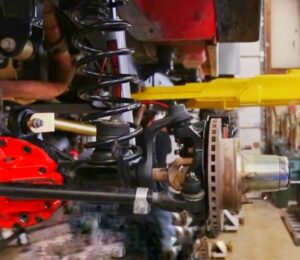
What is the purpose of hub locks?
Hub lock has a mechanism to lock and unlock the wheel hub with the relevant drive shaft, when it rotates.
That is how a manual hub lock works. When we rotate the hub lock to the “Lock” direction , the wheel hub locks with the drive shaft. Then if we try to rotate the wheel hub, the drive shaft also rotates along with the wheel hub.
If we rotate the hub lock to the “Free” direction, the hub will be released from the drive shaft. Then we can spin the wheel hub freely without any spinning of the driveshaft.
At that point the front wheels don’t have any connection with the transfer case through the drive shaft. So front wheels don’t get any power from the engine if hub blocks are disengaged.
This is called locking hubs or free wheeling hubs (FWH). This is the simplest explanation about locking hubs.
What are differential lockers?
Differential is a gear wheel mechanism placed on the middle of the axle. It gives different wheel spinning speeds of the two wheels of an axle.
This wheel spinning difference is very important to take bends for a vehicle.
Because when a vehicle takes a bend/turn, the wheel spinning on the inner side of the bend is travelling a lower distance than the other tire of that same axle. To get this difference, two wheels of an axle should spin at different speeds in a bend.
If both of the tires are connected with a solid axle without a differential, that speed difference could not be achieved. You can read more about differentials in my “What does a center locking differential do?” article.
If you are curious to know whether Limited-Slip Differential (LSD) or Locking differential better for your rig you can read this guide.
What’s the purpose of adding a locking hub to the 4wd vehicles?
As you know there is a transfer case in 4wd vehicles to transfer engine power to the front axle.(you can read the above mentioned article on 4wd and AWD to clarify things furthermore).
When we engage in 4wd mode (putting 4H or 4L) , the transfer case transfers engine power to the front front axle(2 drive shafts) through the front propeller shafts. Then through the front drive shafts front wheels get the power.
What happens if there were no hub locks?
Then let’s think about an instance where this vehicle drives on a highway without engaging in 4wd mode. At that time, the transfer case doesn’t transfer power to the front wheels.
But because of the spin of the front wheels, they rotate the drive shaft and other transfer case components inversely. Reason for that is there are no disengaging mechanisms to cut the connection between front wheels and front drive shafts.
So this is an unwanted thing and also this will give some resistance to the forward movement of the vehicle when 4wd off. This affects the fuel efficiency and unnecessary wear and tear problems of the 4wd drive system also.
Solution: Hub locks
As a solution for those problems hub locks were created. It simply disengaged the front wheels from the drive shaft when 4wd mode switched off.
This can be done either manually or automatically. After hub lock disengaged, the 4wd drive vehicle just acts as a rear wheel drive vehicle.
Does 4×4 work without hubs locked?
Actually what happens if 4wd is engaged and hub locks are disengaged ?
Nothing much. Only rear wheels get the engine power and the vehicle acts as a rear wheel drive vehicle. But here the front driveshafts get the engine power, so they also rotate.
But that rotation won’t transfer to the front wheels because the front wheels aren’t engaged with front drive shafts.
That means 4×4 does not work without hub locks. To get 50% of power transmitting from the engine, front wheels should engage with front drive shafts through hub locks.
What is the difference between automatic and manual locking hubs?
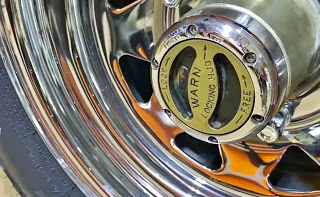
As in the names automatic locking hubs engage automatically when 4wd mode engages in the vehicle. Hub locks disengage automatically when 4wd mode is off. Most of the new vehicles have these locking hubs due to the feasibility.
But some jeep models still use the old school method; manual locking hubs.
In vehicles with manual locking hubs, drivers have to get off from the vehicle and manually lock the hubs of the two front wheels. Their driver has to rotate the locking hub to the lock position/engage from the free position/disengaged position.
You can know everything on automatic and manual hub locks by clicking here.
When should you lock your locking hubs?
In manual locking hubs you lock it when you are ready for using 4wd mode.
Before you do wheeling on mud, sand or rock crawling you can lock your hubs. Or else you can lock your hubs when road conditions/ weather conditions get bad and you think you may need to engage and disengage 4WD from time to time.
Can I leave locking hubs locked?
It’s not a problem if you keep it locked throughout your off-roading adventure whether you engage or disengage 4wd mode. Even on a highway it’s not a problem to keep it locked for short distances.
But for long distance highway trips, keep unlocked. It will give your front wheels to freely spin while your steering ability also increases, reducing the effort to turn the steering wheel. It will increase your MPG also.
Even in an instance your cv joints break you can unlock your hubs and drive like a rear wheel drive vehicle.
How fast can you go with your hubs locked?
There is no maximum speed limit. As long as your front differential lockers are disengaged & in 2H mode, you can drive at any speed.
But it adds extra weight to the engine that causes MPG reduction. Not only that this can cause extra wear out in the front pinion and CV joints.
If you are engaged in 4WD mode, you can keep speed limits according to the 4L or 4H range.
It’s advised to keep your speed below 70mph in 4H gear, concerning safety.
So you can keep your speed in that limit when your hubs lock. But it’s not a rule. With time Locking hubs can be gone bad and cause huge issues to your jeep. You can learn how you can overcome those consequences due to bad locking hubs by clicking here.
Conclusion.
So for now I’ve talked about the hub locks, it was as simple as possible.
I think I gave you a good idea about the difference between hub locks and diff locks. Apart from that you got a good understanding about hub locks, how and when to use them correctly. If you want to know why is it hard turn your steering wheel when engaged in 4WD mode, you can read about that by clicking here.
Here I don’t talk much about differential lockers, because I had talked all the things about a differential in a very understandable way in my “What does a center locking differential do?” Guide.
I’ve described everything in a very simple way using diagrams in that guide. Check that also for a better understanding of this article.
If you think this guide may be helpful for someone else, you can share this with them. You just have to hit a share button below!!
Have fun and safe off-roading pals !!

